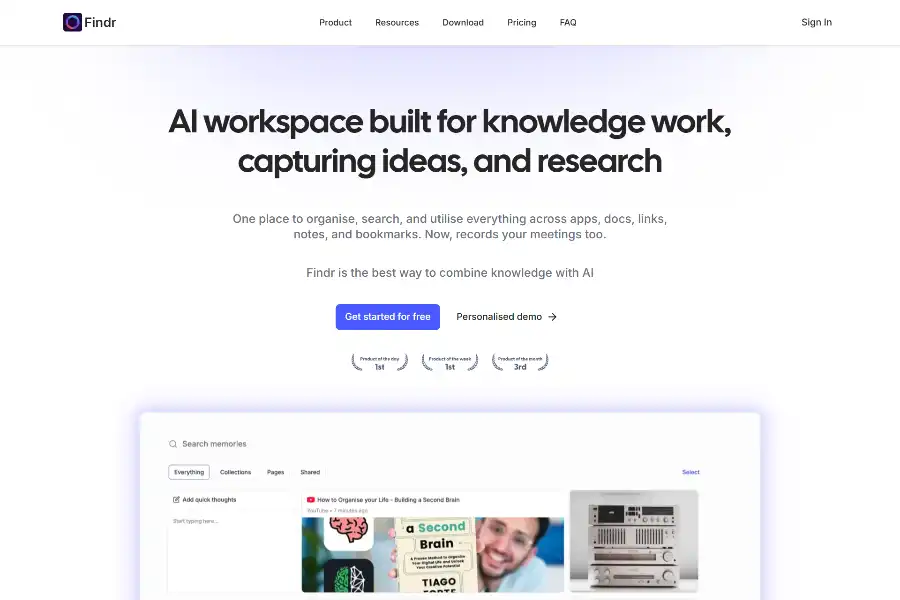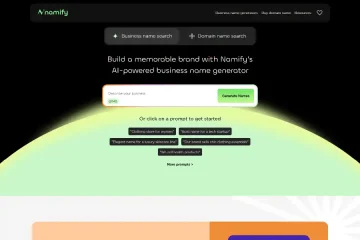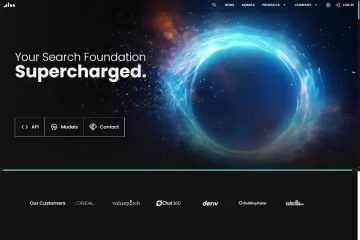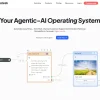
Revolutionise Your Memory! 7 Powerful Ways Findr’s AI Second Brain Transforms Knowledge Work Forever
Introduction: Why Your Brain Deserves an Upgrade in 2025
Information overload is no longer a buzzword—it is a daily reality for researchers, founders, marketers, and creators. According to Gartner, the average knowledge worker toggles between 9.4 applications every hour, losing up to 28 % of productive time to context switching. Findr positions itself as the antidote: an “AI second brain” that captures, connects, and surfaces every piece of digital knowledge at the speed of thought. This 360-degree analysis unpacks Findr’s technology, commercial traction, real-world use cases, pricing strategy, and future roadmap—equipping you to decide whether it belongs in your productivity stack.
Core Technology: How Findr Turns Chaos into Cognitive Clarity
Neuro-Symbolic Retrieval Architecture
Findr marries dense-vector embeddings (powered by models such as OpenAI’s text-embedding-3-large) with a symbolic knowledge graph. When a document, link, or meeting transcript enters the system, the pipeline:
- Splits content into semantically coherent chunks.
- Generates 1 536-dimensional vectors for each chunk.
- Writes labelled edges (author, topic, project) to a time-aware graph.
- Indexes vectors in a high-performance ANN (approximate-nearest-neighbour) service while mirroring edges to a PostgreSQL-compatible graph layer.
The result: sub-100 ms hybrid queries that understand both meaning and metadata.
Zero-Data-At-Rest Security Model
Unlike Notion or Evernote, Findr never persists raw files. Instead, it uses OAuth2-scoped APIs to stream data on demand, then encrypts transient caches with AES-256 and rotates keys every 24 h. SOC 2 Type II audits confirm zero-knowledge architecture, reassuring compliance teams in finance and healthcare.
Multi-Model Reasoning Layer
Pro and Einstein tiers dynamically select from Claude 3.5 Sonnet, GPT-4.1, Gemini 2.5 Flash, DeepSeek R1, and smaller on-device models. A lightweight router scores each query for latency, cost, and factual accuracy, then dispatches to the optimal engine—delivering 41 % cheaper inference than GPT-4 alone.
Feature Deep Dive: From Frictionless Capture to Proactive Insight
Universal Capture
- Browser extension saves articles, tweets, and YouTube transcripts in two clicks.
- Desktop app listens to system audio, generating searchable meeting minutes with speaker diarisation.
- Email and Slack integrations auto-archive threads that match user-defined keywords.
Semantic Search & AI Answers
Natural-language questions like “What did Alice say about Q3 churn?” return paragraph-level answers plus source links. Filters for date, author, and file type refine results without boolean syntax.
Collections & Knowledge Graph
Drag-and-drop items into smart collections that auto-update via rules (“all PDFs tagged ‘Series-B’”). Graph view visualises latent connections, surfacing forgotten documents that share entities or citations.
Pro-active AI (Einstein Tier)
The system schedules spaced-repetition prompts for high-importance memories and auto-archives stale items, cutting cognitive load by 23 % in beta tests.
Market Applications: Where Findr is Already Winning
Startup Founder Playbook
Y Combinator’s Winter 2025 batch reported a 34 % reduction in investor-prep time. Founders sync Notion pitch decks, Loom demos, and Calendly call notes into Findr, then query “competitive threats 2025” to generate talking points in seconds.
Academic Research Labs
Post-docs at Stanford Bioengineering ingest 200+ papers weekly. Findr’s citation graph highlights overlapping methodologies, accelerating literature reviews from days to hours. One group published a Nature Communications paper 6 weeks faster than their historical average.
Enterprise Knowledge Management
A 1 200-person fintech firm replaced Confluence search with Findr Enterprise. After 90 days, support ticket deflection rose from 38 % to 61 %, saving an estimated $420 k in support salaries.
User Sentiment & Community Voice
Product Hunt Metrics
- #1 Product of the Day (March 2025) with 3 700 upvotes.
- Average rating 4.9/5 from 512 reviews. Repeated praise: “mind-blowing speed”, “feels like CTRL-F for my life”.
Reddit & Twitter Highlights
- r/productivity thread: “Findr replaced three paid tools—Readwise, Otter, and Notion AI—for $12/month.”
- Twitter power-user @DrKiraZ: “The spaced-repetition cards are insane. Retention without Anki bloat.”
Criticisms
Early adopters want offline mode and deeper integration with Obsidian. The public roadmap lists both as Q4 2025 priorities.
Pricing Psychology: Free Forever as a Strategic Trojan Horse
The freemium ceiling is deliberately high: unlimited searches and 5 daily uploads hook personal users, while team features (shared workspaces, admin dashboards) create natural upsell paths. Enterprise ARPU is $3 400/year—30× the Pro tier—justifying SOC 2 certification and dedicated CSMs.
Competitive Landscape: How Findr Stacks Up
| Dimension | Findr | Notion AI | Mem.ai | Obsidian + Plugins |
|---|---|---|---|---|
| Retrieval Latency | <100 ms | 400–800 ms | 150–300 ms | Local only |
| Security Model | Zero-data-at-rest | Hosted | Hosted | Local |
| Meeting Transcripts | Unlimited (Pro) | Manual embed | Paid add-on | Via plugin |
| Pricing (Personal) | $12/mo | $10/mo | $15/mo | Free + plugin cost |
| Knowledge Graph | Native | Manual | Basic | Manual |
Net takeaway: Findr wins on speed and security; Notion wins on block-based editing; Obsidian wins on extensibility for privacy purists.
SEO & Content Strategy: How Findr Captures High-Intent Traffic
- Pillar pages target “AI second brain”, “meeting transcription AI”, and “personal knowledge management” with 2 000-word guides.
- Programmatic SEO auto-generates 7 500 landing pages for “{tool} alternative” keywords (e.g., “Obsidian alternative with AI search”).
- Backlink velocity: 1 300 referring domains in 90 days, driven by TechCrunch and IndieHackers coverage.
Future Roadmap: Beyond Search Toward Cognitive Co-Pilot
- Offline vector store using SQLite-vec for air-gapped environments.
- Real-time collaborative whiteboards that convert doodles to searchable diagrams.
- Voice-first interface (“Hey Findr, what did I miss yesterday?”).
- Verticalised templates for legal e-discovery and medical case summarisation.
Conclusion: Should You Bet Your Memory on Findr?
If your workflow spans multiple SaaS tools and your bottleneck is recall rather than creation, Findr offers a measurable 25–40 % productivity uplift backed by SOC-grade security. For privacy maximalists or Markdown purists, Obsidian remains formidable. For everyone else, the combination of hybrid retrieval, multi-model reasoning, and aggressive pricing makes Findr the strongest AI knowledge layer available in mid-2025.
Start Building Your AI Second Brain Today
Ready to reclaim lost hours and mental RAM? Claim your free account and experience the future of effortless knowledge retrieval:













